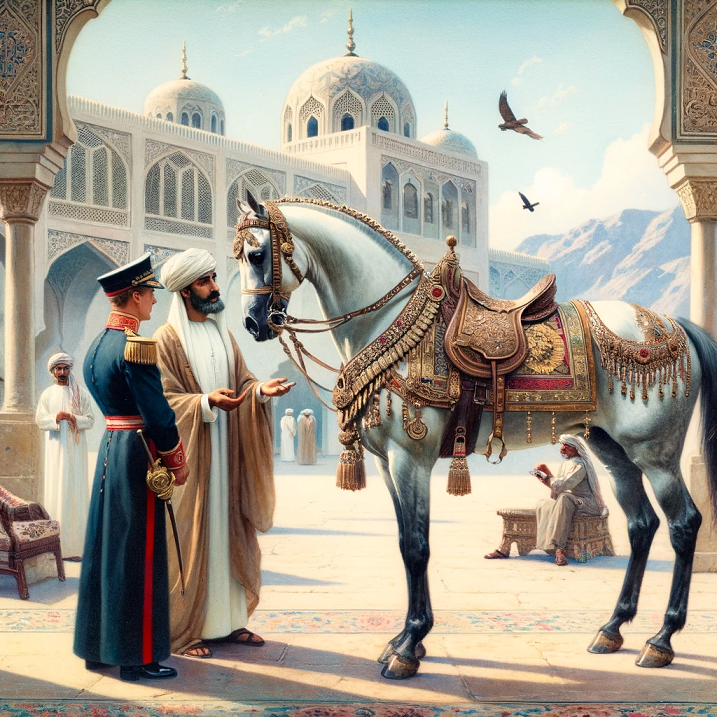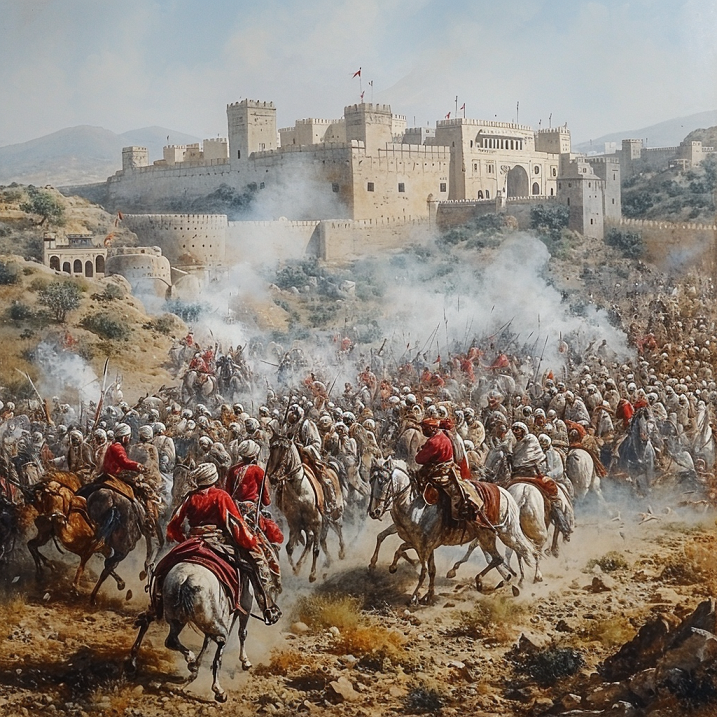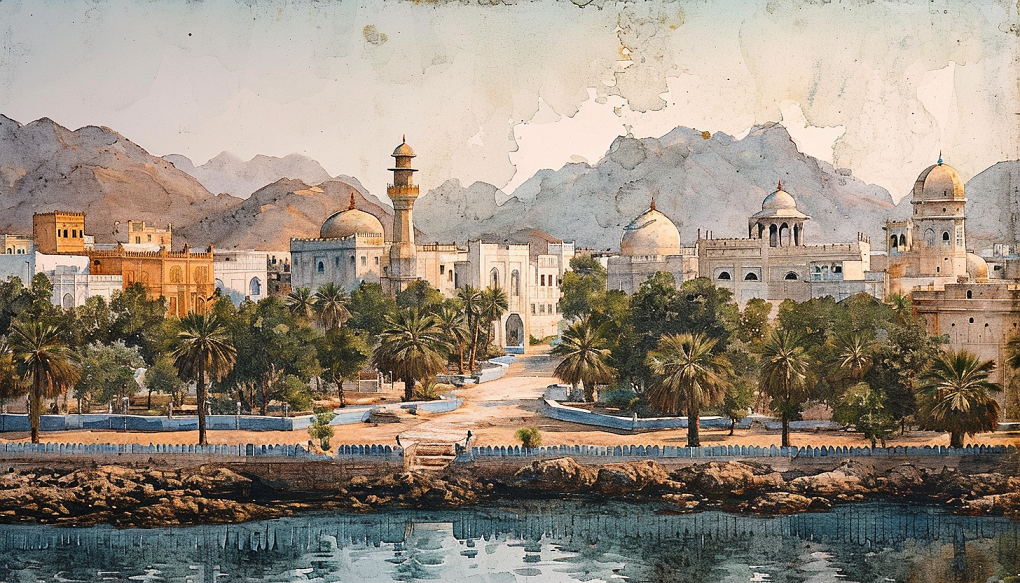James Wellsted, a British explorer and author, embarked on a remarkable journey through Arabia, chronicled in his book titled “Travels in Arabia.” Wellsted’s expedition commenced in a period when the majority of Arabia’s northern frontier, Mecca, and Medina had already been explored. Travellers like Burckhardt had offered insights into the immediate vicinity of these holy cities, while Niebuhr had ventured into a small part of Yemen. However, vast provinces, such as Hadramaut and Oman, remained shrouded in mystery, as did the western side along the Persian Gulf.
Key Takeaways:
- The geography of Oman presented a striking contrast, with cultivated spots along its borders and vast arid and sandy wastelands in between.
- Wellsted’s journey was made possible through a partnership with the generous Imam, Sayyid S’aid, the ruler of Muscat, who provided invaluable support and resources.
- Muscat, as the port city of Oman, held historical significance as a vital emporium for trade between India, Persia, and Arabia.
- The forts and defences surrounding Muscat underlined its strategic importance, with two half-moon batteries guarding the entrance to the cove.
- The expedition marked the beginning of Wellsted’s exploration of the rugged and uncharted terrains of Oman, with a route leading to the Jebel Akhdar, the Green Mountains.
Mohammd Ali Pasha’s Yemen Expedition
Wellsted’s curiosity for these uncharted regions was piqued on the survey of the southern and western coasts of Arabia. Despite his continuous efforts to gather knowledge about the adjacent provinces, opportunities for successful exploration remained elusive until the early months of 1835. It was during this time that the ambitious and expansionist agenda of Mohammed Ali, the ruler of Egypt, came into play. Mohammed Ali dispatched a force from Egypt with the intention of seizing control of the ‘Coffee country’ (Yemen).
Wellsted seized the opportunity to accompany this Ottoman Egyptian force and extend his exploration to Hadramaut. The Indian government promptly endorsed his proposal, envisioning a mutually beneficial endeavour. However, before the official sanction could reach him, reports arrived of the Egyptian force’s misadventures in the Assa’ir country, leading to their defeat and a mere remnant reaching the sea-shore. Disheartened by this setback, Wellsted returned to Bombay, where he redirected his attention to the unexplored territories of Oman.
Oman, a land often associated with the presumed hostility of its inhabitants, had remained untouched by European explorers. Wellsted was drawn to this enigma, driven by the allure of its uncharted landscapes and its people, who remained largely unknown to the world. His plan was further motivated by the political relations between Oman’s ruler, Sayyid S’aid, and the British government. It was a rare opportunity to bridge the gap between curiosity and discovery.
With the necessary permissions secured, Wellsted devoted several days to acquire the essential letters and presents for his journey. On the 9th of November, 1835, he set sail on the small schooner “Cyrene,” embarking on a voyage that would unlock the secrets of Oman’s uncharted territories and introduce the world to the captivating landscapes and cultures of this enigmatic land.
Preparations for the Journey
As James Wellsted’s schooner sailed towards Muscat, the port city that would serve as his entry point into Oman, he carried with him the anticipation of uncovering the mysteries concealed within this uncharted territory. Upon his arrival at Muscat on the 21st of November, 1835, Wellsted’s journey began in earnest, and he wasted no time in initiating contact with the local authorities.
One of the crucial figures he sought to meet was the Imam of Muscat, Sayyid S’aid. Wellsted’s aspirations and objectives rested heavily on securing the cooperation and support of the Imam. This initial encounter, which took place shortly after his arrival, marked a pivotal moment in his journey.
On the 22nd of November, Wellsted had the opportunity to meet with the Imam. However, upon his arrival at the Imam’s residence, he found that a full divan, or council, was already in session. Undeterred, Wellsted respectfully requested a private audience with the Imam, a request that was promptly granted. It was during this private meeting that the foundations of their collaboration were laid.
An Audience with The Ruler Of Oman
The meeting with Sayyid S’aid would prove to be a turning point in Wellsted’s journey. The Imam’s personal qualities left an impression on the explorer. Sayyid S’aid, though holding a position of great authority and responsibility, exuded an air of generosity and warmth. His personal character was a testament to his noble bearing and enlightened disposition.
As Wellsted presented himself before the Imam, he was not only struck by the warmth of the reception but also by the genuine eagerness displayed by Sayyid S’aid to support and facilitate the objectives of his expedition. Sayyid S’aid conveyed his pleasure in assisting Wellsted, emphasising that such opportunities allowed him to demonstrate his attachment to the British government.
In the Imam’s words, “These are not words of the tongue, but of the heart.” This sincerity and wholehearted support provided Wellsted with a strong foundation for his journey. As they engaged in conversation, the Imam’s extensive knowledge of the country and his genuine desire to assist Wellsted in achieving his mission became evident.
Planning The Route
It was during this meeting that the specifics of Wellsted’s journey were discussed and arranged. Given that there was only one viable road to the southward regions he intended to explore, a decision was made to proceed first to Sur. From there, the plan was to continue on to Beni-Abu-‘Ali, and subsequently traverse a route roughly parallel to the sea-shore, leading to the Jebel Akhdar, or the Green Mountains. These mountains were described as elevated, populous, and fruitful, making them an enticing destination for exploration. Following this phase, Wellsted’s itinerary would include further exploration of Oman and, if circumstances allowed, a journey to Der’ayyah, the capital of the Wahhabi state.
Additional details and arrangements were made during the meeting, including the preparation of letters under the Imam’s direct supervision. These letters were intended for the chiefs of various districts along Wellsted’s route, instructing them to receive the explorer with the utmost attention and civility.
With these preparations in place and a supportive ally in Sayyid S’aid, James Wellsted departed from this pivotal meeting, his spirit buoyed by the prospects of a successful journey. The stage was set for his exploration of Oman, a land hitherto untraveled by Europeans, and the beginning of a captivating adventure into the heart of the Arabian Peninsula.
Gifts from the Sayyid
On the morning of November 23rd, Wellsted once again found himself in the presence of the Imam. However, this time, the private audience took place under different circumstances. Wellsted’s anticipation was met with a display of generosity and support that surpassed his expectations.
During this meeting, the Imam made a series of remarkable gestures that would greatly benefit Wellsted’s expedition. First and foremost, the author received a fine Nejd horse for his journey. This horse, prized for its strength and endurance, would prove invaluable in navigating the challenging terrains of Oman.
In addition to the horse, Wellsted was presented with a pair of greyhounds. These agile and swift dogs were not only prized for their hunting prowess but also had practical utility in the exploration of vast and often remote landscapes.
To further equip Wellsted for his journey, the Imam presented him with a gold-mounted sword. This weapon, adorned with gold accents, symbolised both protection and prestige, reflecting the seriousness with which the Imam regarded the expedition.
However, the Imam’s support extended beyond material gifts. He assured Wellsted that throughout his stay in Oman, he would have access to the very best that the country had to offer. This commitment included covering all expenses related to camels, guides, and other necessities, demonstrating the Imam’s unwavering dedication to the success of the mission.
November 22nd. I found no one with his Highness this morning but his son, and after delivering my presents, a few words sufficed to explain the objects of my proposed journey. Prepared as I was by my previous knowledge of Sayyid S’aid’s characteristic liberality to meet with no unfavourable exception to these, I was surprised out of all former conception by the eagerness he displayed to further my views. “It is occasions like these,” he said,” which afford me real pleasure, since they enable me, by meeting the wishes of your government, to evince the strength of my attachment to them.
James Wellsted: Travels in Arabia

The culmination of these gestures left James Wellsted deeply moved. The sincerity and warmth with which Sayyid S’aid supported the mission were beyond his expectations. It was clear that the Imam’s willingness to assist in the exploration of Oman was driven by a genuine commitment to strengthening the relationship between his principality and the British government.
Observation on The Ruler of Muscat
Sayyid S’aid, the Imam of Muscat, stood as a remarkable figure in Oman’s political landscape. Aged fifty-two and having reigned for twenty-seven years, he possessed both the experience of leadership and the wisdom that comes with it. His physical presence was commanding, marked by a tall stature and a striking countenance that combined strength with a gentle demeanour.
The Imam’s personal habits and lifestyle were emblematic of his frugality and simplicity, qualities that contrasted with the opulence often associated with rulers. Notably, Sayyid S’aid eschewed the wearing of jewels, a stark departure from the ostentatious displays common among leaders of his era.
In his personal habits, the Imam has preserved the simplicity of his Bedowin origin ; he is frugal almost to abstemiousness; he never wears jewels ; his dress, excepting in the fineness of the materials, is not superior to that of the principal inhabitants; and he is attended, on all occasions, without pomp or ostentation.
James Wellsted: Travels in Arabia
His attire, while crafted from fine materials, did not boast extravagant embellishments. This modest approach to clothing, typical of the principled inhabitants of Oman, reflected Sayyid S’aid’s attachment to tradition and his reluctance to embrace lavishness.
Perhaps one of the most endearing aspects of the Imam’s character was his humility and devotion to family. Despite his elevated position, he continued to pay daily visits to his mother, who was still alive. This practice was not merely a matter of tradition but was indicative of the genuine warmth and affection that Sayyid S’aid maintained for his family.
The Imam’s principled and benevolent rule had not gone unnoticed in the region. His character and governance had garnered him the title of the “Second Omar” throughout the East. This comparison to the famed Caliph Omar ibn al-Khattab, known for his just rule, highlighted the esteem in which Sayyid S’aid was held.
On the other hand, his probity, the impartiality and leniency of his punishments, together with the strict regard he pays to the general welfare of his subjects, have rendered him as much respected and admired by the town Arabs, as his liberality and personal courage have endeared him to the Bedowins. These splendid qualities have obtained for him throughout the East the designation of the Second Omar.
James Wellsted: Travels in Arabia
Sayyid S’aid’s lineage could be traced back to Ahmed Ibn S’aid, who, in 1730, liberated Oman from Persian control. The title “Imam” was significant in Oman’s political landscape. To earn this title, a ruler needed to possess the requisite theological knowledge to preach before assembled chiefs during his election.
However, Sayyid S’aid did not assume the title of Imam, primarily due to his perceived lack of the necessary theological qualifications. Instead, he adopted the title of “Sayyid,” signifying a prince or leader. This distinction did not diminish his influence or authority but reflected his commitment to adhering to traditions and principles.
18th Century Muscat: Geogrpahy & Society
As James Wellsted’s journey through Oman took shape under the generous patronage of Sayyid S’aid, it was essential to appreciate the historical and geopolitical context in which his expedition was set. The principality of Muscat, where the author had established a vital partnership with the Imam, held a unique position within the Arabian Peninsula.
Various notices of this town may be found in the pages of Niebuhr, Hamilton, and others, but they mostly refer to a remote period, and are now, from the great change which its condition and commerce have experienced under its present ruler, scarcely applicable to it.
James Wellsted: Travels in Arabia
Muscat, situated at the very extremity of a small cove, offered a captivating and enigmatic entry point to Oman. The geography surrounding the port was awe-inspiring, with hills rising almost perpendicularly from the sea to heights ranging from three to five hundred feet. These hills, adorned with forts, framed the coastline dramatically, creating a formidable yet picturesque setting.

The forts flanking the entrance to the cove served as a testament to Muscat’s strategic importance. Considering the location within the Arab world, where political landscapes could shift rapidly, the defence of the port was a priority. The largest and most commanding of these forts were positioned on either side of the cove’s inner extremity. On the western side, a particular fort served as a place of confinement for state prisoners, a reminder of the complex dynamics of the region.
To secure the entrance to the cove, two half-moon batteries were strategically placed, each housing guns that were well-maintained and diligently guarded. These fortifications were a clear indication that the authorities took their defence seriously. The narrow half-mile gap between these forts would have posed a significant challenge to any open attack, especially during daylight hours.
When viewed from the sea, Muscat presented a striking visual contrast. The absence of vegetation, marked by a barren and arid landscape, made the town’s whitewashed buildings and turreted forts stand out in stark relief. The buildings’ whitened surfaces, gleaming in the sun, created a vivid juxtaposition with the dark, rocky masses that surrounded them. This spectacle was characteristic of many eastern cities when observed from a distance, promising grandeur and allure that sometimes faded upon closer inspection.
To persons arriving from seaward, Muscat with its fort and contiguous hills, have an extraordinary and romantic appearance.
James Wellsted: Travels in Arabia
Upon disembarking and venturing into the town’s interior, Wellsted’s initial impressions underwent a transformation. The narrow, congested streets, cluttered bazaars, and bustling porters carrying loads of dates and grain painted a picture of a bustling yet cramped urban center. Wretched huts and modest houses, some in advanced states of decay, greeted the eye at every turn.
Yet, amid this apparent disorder and decay, there were pockets of substance and distinction. Muscat housed several substantial and handsome houses, including the palace of the Imam himself. These structures, in contrast to the more humble dwellings, reflected a different architectural style influenced by Persian aesthetics.
Muscat is built on a slope, rising with a gradual ascent from the sea, where the water nearly washes the bases of the houses. This side has no defence, but the others are protected by a wall fourteen feet high, with a dry ditch. The entrance is by two gates, which they close every night at sunset.
James Wellsted: Travels in Arabia
Muscat’s unique position as the port city of Oman and its complex history set it apart from other towns in the region. Historical records revealed that the ancient geographers, such as Ptolemy and Arrian, were aware of the city’s strategic location. It was likely the Moscha mentioned by Ptolemy, a vital port in the Hadramite region. Arrian’s “Periplus of the Erythrean Sea” further underlined Muscat’s significance as a thriving emporium for trade between India, Persia, and Arabia.
However, it was the Portuguese who fundamentally altered Muscat’s trajectory when they seized the city in 1508. Recognizing its potential as an intermediate port for their Indian and Persian Gulf routes, the Portuguese invested substantial effort in fortifying the town. The legacy of their presence endured in the form of forts and churches.

The city’s history also bore the scars of more recent conflicts. When the Persian Emperor Shah Abbas captured the nearby city of Ormuz in 1622, Muscat became a refuge for many of its wealthiest inhabitants. Yet, in 1658, the town was retaken by Arab forces who ruthlessly executed the Portuguese garrison. Today, the forts and two churches, one in ruins and the other converted into a palace for the Imam, were the remaining vestiges of that era.
In the period between the Portuguese era and Sayyid S’aid’s ascendancy, Rustaq was considered the capital of Oman. Muscat, though historically significant, was not the center of governance. This shift in the capital’s location marked the evolving dynamics of the region.
FAQ:
Q: Who was James Wellsted, and what was the focus of his journey?
A: James Wellsted was an explorer in the early 19th century, and his journey focused on exploring the largely uncharted region of Oman.
Q: What role did Sayyid S’aid, the Imam of Maskat, play in Wellsted’s expedition?
A: Sayyid S’aid provided crucial support and resources for Wellsted’s journey, including gifts, financial assistance, and letters to ensure his safety and courtesy along the route.
Q: Why was Maskat historically significant, and what was its geographical setting?
A: Maskat served as an important emporium for trade between India, Persia, and Arabia, and it was characterized by its dramatic setting nestled between hills rising from the sea.
Q: What challenges did Wellsted and his companions face in Oman?
A: The expedition encountered rugged terrains, arid deserts, and rocky mountains, making the journey challenging and the landscapes unforgiving.
Q: What was the ultimate goal of Wellsted’s exploration in Oman?
A: Wellsted aimed to uncover the mysteries of Oman’s geography, culture, and people, leaving behind a legacy of knowledge for future generations.

